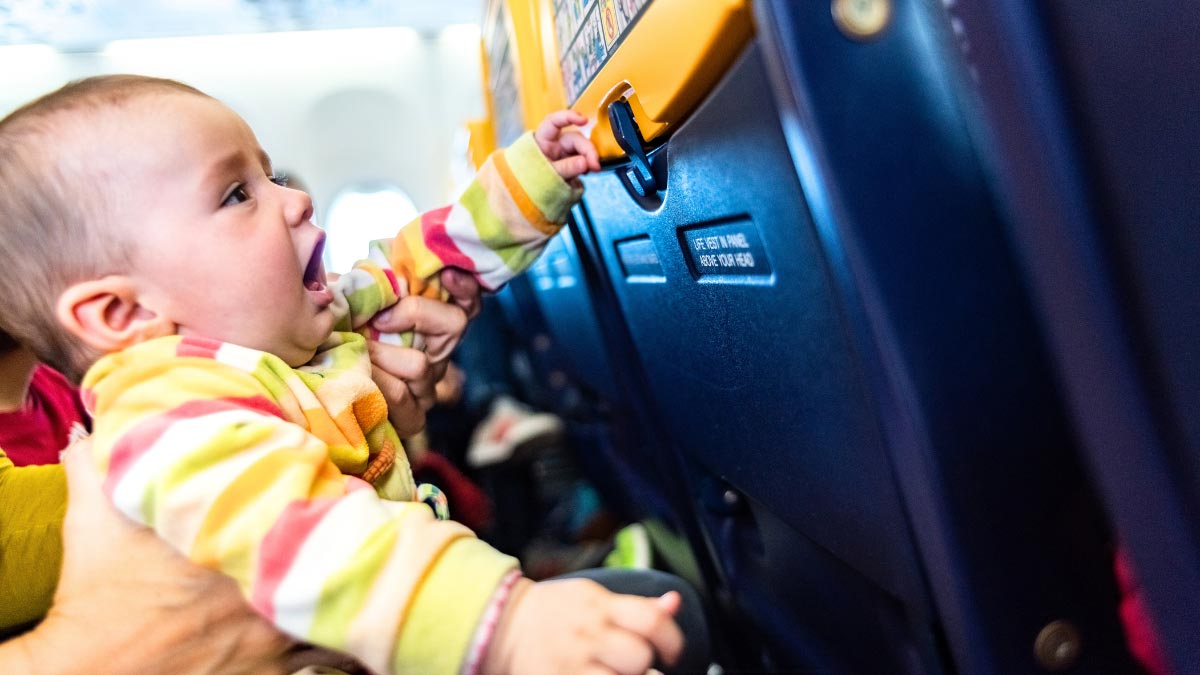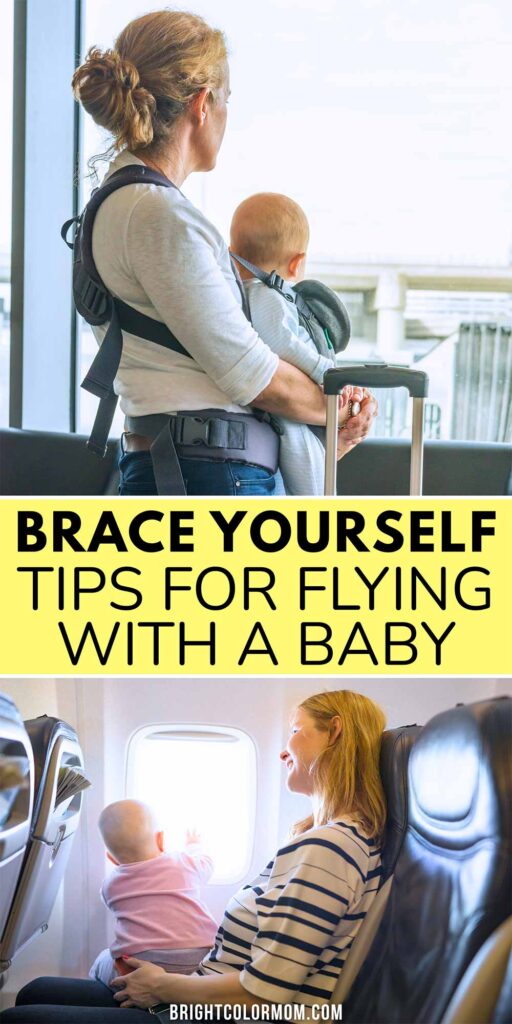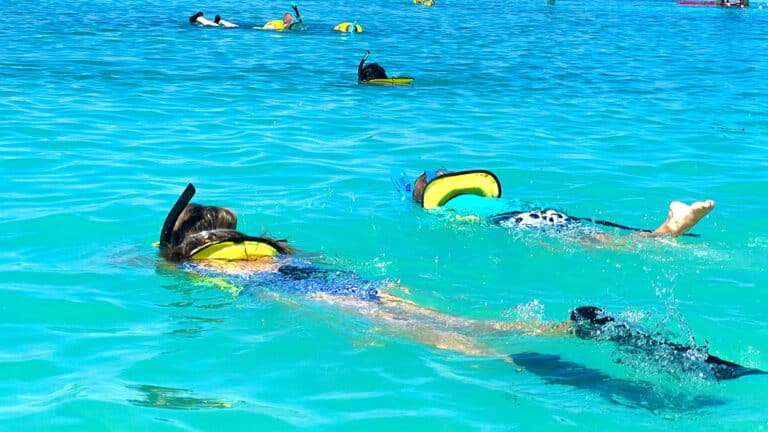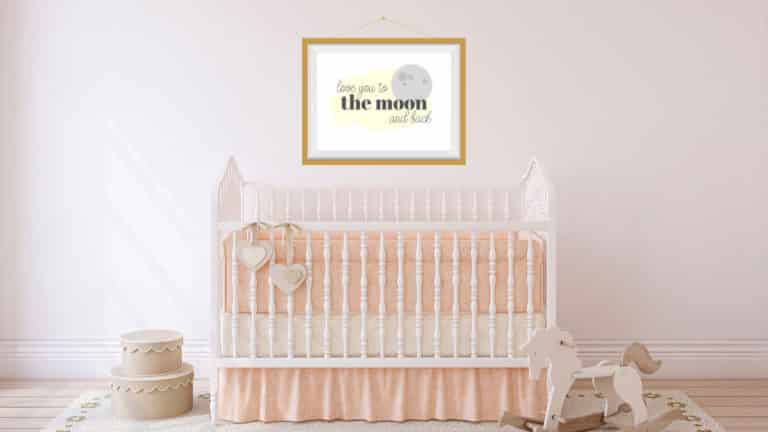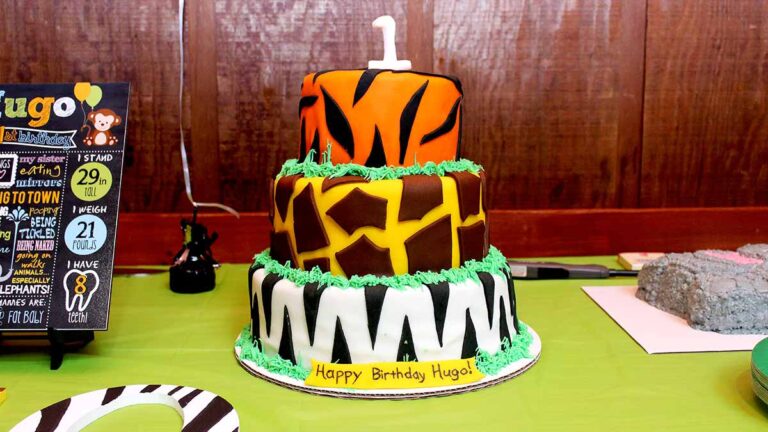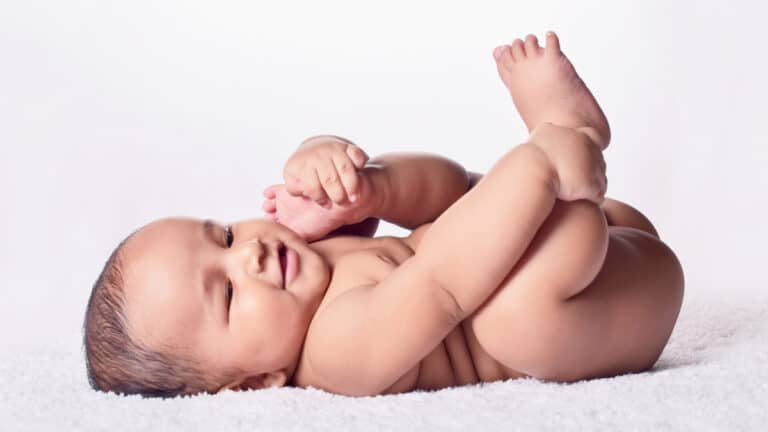So you’re about to board a metal tube in the sky… with a baby. Deep breath! You’re not the first parent to do it, and you won’t be the last. But if this is your first flight with a baby, you probably have questions. And possibly a mild case of preemptive dread. But flying with a baby is entirely possible, it just takes a lot of preparation.
This guide covers everything you need to know – from what to pack to how to handle a diaper blowout at 35,000 feet. It’s built for parents like you, who want to survive (and maybe even enjoy?) flying with a baby. And it would be nice if all the other passengers didn’t hate you by the time you land. In addition to answering your questions, I’ve got a lot of tips for flying with a baby. Let’s do this!
When it’s Safe to Fly with a Baby
Determining how soon you can fly with a baby is two-fold. You need to consider both your pediatrician’s specific recommendations as well as your preferred airline’s newborn policy.
Doctor’s Orders
If your baby is born full-term without any apparent health issues, it’s considered acceptable to fly as soon as 7 days later. If your baby is pre-term or does have health concerns, it is best to wait as long as possible, preferably to the 2- to 3-month mark on average.
The longer you wait, the more developed baby’s immune system will be and the more vaccinations they will likely have had. Travel is one of the most common ways for germs to be spread. Keep in mind that it’s never possible for newborns on any life-sustaining machines to fly.
Major Airline Rules
Each airline has its own policy for traveling with babies, so make sure you double-check their guidelines before booking. No matter which airline you choose, you should take your baby’s birth certificate or passport as proof of their age. You aren’t allowed to book seats in the exit rows with a baby, and some airlines also specify you can’t use the rows in front of or behind them, either.
American Airlines
- Newborns can fly as young as two days old
- Babies under 7 days old require a doctor’s note stating they are cleared for travel
- Lap infants are accepted until two years old
- One baby per adult; additional infants will need a ticket and car seat
Delta Airlines
- Newborns can fly starting at 7 days old
- Babies under 7 days old require a doctor’s note stating they are cleared for travel
- Lap infants are accepted until two years old, but fees may be required for international flights
- One baby per adult; additional infants will need a ticket and car seat
- Federal Aviation Administration (FAA)-approved car seat required for ticketed infants
United Airlines
- Same policies as Delta!
- They specifically recommend making sure you purchase a seat wide enough for your baby’s car seat, if not taking as a lap infant
- One adult is guaranteed a seat next to your baby for free
Southwest Airlines
- Newborns can fly starting at 14 days old
- Lap infants are accepted until two years old, but fees may be required for international flights
- A Boarding Verification Document (BVD) is required, which can be obtained at the airport; you’ll need the baby’s birth certificate
- One baby per adult; additional infants will need a ticket and car seat
JetBlue Airways
- Newborns can fly starting at three days old
- Infants between three and 14 days old must have a doctor’s note for travel
- Lap infants are accepted until two years old, and fees are only charged when traveling from a foreign location back to the U.S.
- A notarized letter is required if you are not the baby’s parent or guardian
Spirit Airlines
- Newborns can fly starting at 7 days old
- Lap infants are accepted until two years old
- Lap babies may fly with guests 15 years of age or older
- FAA-approved car seat required for ticketed infants
- Diaper bags do not count against your personal item
- They do not specifically guarantee you a seat next to a ticketed baby if you don’t purchase seat assignments (and the U.S. is still fighting to make this law)
This post may contain affiliate links. If you make a purchase after clicking one, I may receive a small commission at no cost to you.
Before You Book: Planning Your Baby’s First Flight
Booking a flight with a baby isn’t just about finding the cheapest fare. It’s about stacking the odds in your favor.
Choose Your Time Wisely
Morning flights tend to be less delayed and babies are often fresher early in the day. Evening flights can sync with bedtime, but overtired babies on red-eyes? Risky. I learned to save the night travel for road trips and stick to daylight hours for flights with my babies.
If your time of year for vacation is flexible, try to avoid the winter months. RSV is rampant in colder temperatures and makes babies so, so sick – my son caught it at just two months old, and it was scary.
Planning a post-birth trip before your baby is even born? You should consider how you’re going to feel after delivery. Some women with vaginal deliveries are 100% good to go a week after childbirth. But for me, C-sections were brutal, with the second recovery being even harder than the first. Sure, I could walk the very next day, but that doesn’t mean I wanted to. The thought of going on vacation within two or three months of delivery would’ve been a hard pass.
Direct Flights Beat Layovers
If you can afford it, go direct. Every takeoff and landing adds more ear pressure changes and opportunity for meltdowns. But if your baby thrives on movement, a longer connection may work in your favor. Personally, the risk of the car seat and stroller (not to mention the luggage) not getting transferred to the next flight was always enough for me to fly direct.
Seat Strategy
Lap infants can fly free domestically, but buying a seat for your baby and using an FAA-approved car seat is the safest option. Makes sense, right? We don’t drive around in cars with babies in our laps anymore.
I totally understand wanting to go the lap infant route to save money. But if you’re going to have a ton of luggage (and you will with all that baby gear!), buying your baby a ticket might be particularly worth it. If an airline includes any free checked bags with a seat purchase, this applies to a ticketed baby, too. Weigh the cost of the ticket against the cost of checking those additional bags.
Bulkhead seats offer extra space, but no under-seat storage. Aisle seats make heading to the restroom for diaper changes easier, but you should consider the risk of coffee spills from the snack carts or items falling from overhead bins. If you’re using a car seat, you’ll have to choose a window seat for your baby. Window seats for you offer privacy for feeding. Decide what’s most important to you and pay the extra to choose your own seats.
For me, rows closest to the restroom were my priority – for obvious reasons. I always traveled with my husband so one of us would have a window seat and one an aisle seat, but if I were alone, I’d probably go for the aisle seat, even with a lap baby. It’s just not easy to climb over a stranger with your baby for a diaper change.
Bassinet Option
Some airlines offer bassinets for international (aka long) flights, and these can help your baby sleep better. Most require your baby to be under six months old and less than 20 pounds. American Airlines has them on a first-come, first-serve basis right at the gate. The following airlines have them available to reserve by calling after booking your flight:
- United Airlines
- Delta Airlines
- Hawaiian Airlines
The following airlines do NOT offer bassinets:
- JetBlue Airways
- Spirit Airlines
- Alaskan Airlines
- Frontier Airlines
Consider Travel Insurance
Life gets incredibly unpredictable once you have a baby. Babies get sick. So do parents! A refundable ticket or family travel insurance can save your wallet if plans change suddenly. I have always purchased my insurance with Allianz, and they usually allow you to buy insurance all the way up until your travel actually starts.
Just know that if the airline gives you credit for a future flight, Allianz probably won’t reimburse you for the first ticket! In this case, booking a nonrefundable may be the better option if you’re worried the trip might be canceled for good.
Get a Passport
Assuming you have enough time before your flight (ideally 6-8 weeks), apply for a passport for your baby. They are required for international flights, even for babies. But they also make proving your baby’s age and identity a LOT easier. Any additional “investigation” by airport security is made quick when a passport is on file.
Prepare for Changing Time Zones
If you’re crossing significant globe space, it’s going to give you jet lag – and your baby’s will be even worse. Shift sleep and feeding schedules slightly every day for several days before flying. I recommend shifting things half an hour in the direction of your destination time zone each day, but don’t do this for more than a week. If you’re going clear across the world, just spend a week on this and hope for the best!
Register for TSA PreCheck
A fairly new service, PreCheck lets you go through a much shorter line where you can keep your shoes and jacket on! It’s available at most airports, but not all, so check yours first. It does cost extra, but with a baby, spare no expense for convenience and less stress.
Request Assistance
An unfortunately little-known fact is that you can actually contact the airline (or their staff in your airport) for something called Special Assistance before you arrive! It’s free, and the airline will arrange for a member of their staff to help you through the pre-flight process from checking bags and gear to getting to the gate. USE THIS SERVICE, particularly if you are traveling solo with a baby!
Checklist for Flying with a Baby
Try not to carry on more than your baby and diaper bag. Unfortunately, an additional carry-on might be unavoidable, so make sure you have a backpack-style diaper bag. Packing for a baby is a little like playing Tetris in survival mode because there is SO much necessary stuff. Here are the baby travel essentials for the airplane you need to win.
If you’d like to see my specific gear recommendations, check out my suggested baby travel essentials!
Diaper Bag (aka Your New “Personal Item”)
- Diapers (2 per hour of flight, just in case)
- Wipes (a big pack)
- Extra baby clothes and a spare outfit for you
- Pacifiers, teethers, and favorite toys
- Burp cloths, bibs, and plastic bags for wet or dirty stuff
- Sanitizing wipes
Pro tip: Stash a few diapers and a pack of wipes in ALL your bags. You never know when you might be temporarily separated at the airport, and baby could potentially end up separated from the diaper bag during inspection or a food run! Make sure each adult’s carry-on has the changing essentials to avoid a headache.
Feeding Tools
- Bottles, nipples, and sterilized water
- Battery-powered milk warmer
- Formula in a portioned dispenser
- Breast pump (if needed), storage bags, cooler, and/or nursing cover
- Snacks or puree pouches if baby is eating solids
- Bibs, spoons, and patience
If you’re taking a particularly long flight, solid food might actually be a necessity. But my best advice is that if your flight is a few hours long or less, skip the solid meal and just feed milk for the time being. Your baby will be just fine, and it will save you a lot of fuss on the plane.
The Transportation Security Administration (TSA) allows breast milk, formula, and baby food in “reasonable quantities”, even over 3.4 oz. Pack breast milk, formula, and your distilled water for mixing separate from your other items where you can easily grab them for TSA screening.
Travel Gear
- Lightweight travel stroller or umbrella stroller
- Baby carrier or wrap
- White noise machine or app
- Blanket or sleep sack
- Pediatrician’s letter (if your baby is less than 7 days old)
- FAA-approved car seat, if your baby has their own ticket
Not sure if your car seat is the right kind? Look for a tag or label that says “This restraint is certified for use in motor vehicles and aircraft.”
These lists are just the things you’ll need in the airport and on the plane. Check out my baby travel checklist for a comprehensive packing list and get a FREE printable PDF!
What You DON’T Need
Real quick, I want to touch on something that you should not be packing: goodie bags for all the other passengers. I don’t know why someone decided to start this trend, but it’s my mission to squash it. That’s more stuff to pack, space taken up in your carry-on, and more pre-planning stress that someone with a baby just doesn’t need! Do NOT entertain this idea. Those passengers are going to love or hate your baby regardless of the stuff you hand them in a little cellophane bag.
Inside the Airport
Stroller Strategy
If pushing your stroller and/or carrying your car seat through the airport sounds like a nightmare, you can check them along with your luggage. Just make sure you bag them both up (separately) to help keep them clean and easy-to-spot after landing.
Most parents gate-check strollers and car seats (for free). This lets you use them through the airport, and they’re slightly less likely to get damaged when they’re stowed right before boarding. Tag them at the counter and drop them at the plane door. But if you’ve purchase a seat for your baby, hang onto your car seat! Babies aren’t big enough to use the Child Aviation Restraint System (CARES) on planes.
At the gate, you can always ask if your particular flight is completely full or not. If it’s not, even if you didn’t buy your baby a ticket, they may allow you to use an empty seat for your baby’s car seat. Just don’t count on this, and be prepared to handle a lap infant the whole flight after checking the seat.
TSA Tips
Wear your baby in a carrier and you can usually keep them on during screening! Formula and breast milk can go through, but they’ll probably get swabbed. It won’t hurt them to go through the X-ray machine. Tell your TSA agent as soon as you get to the front of the line and they’ll know what to do.
Use the Amenities
Look for nursing pods and family restrooms in your terminal. They’re not glamorous, but they beat feeding and changing your baby by Gate B18.
Speaking of changing, try to change your baby’s diaper immediately before boarding. Not only is a dry baby more likely to be happy on the flight, this reduces the likelihood of you having to do any diaper changing on shorter flights.
Boarding First vs. Last
Airlines usually offer pre-boarding for families, which sounds helpful. But consider waiting until the last minute – babies don’t love sitting on a plane that’s not moving (or any plane, really, but you get the idea). And those cries suddenly feel a lot louder on a plane than they did in the crowded terminal.
If you’re worried about holding up the whole takeoff because you need time to get situated, though, go ahead and use that early boarding perk.
On the Plane
Takeoff and Landing = Pressure
If you’ve ever flown before, you’re probably familiar with that need to swallow and pop your ears during the ascent and descent. This is a result of pressure changes between the outer and middle ear. To protect baby’s ears, feed during ascent and descent. The sucking action from bottles, nursing, or pacifiers help relieve ear pressure caused by cabin changes. You can chew gum to help yourself, too!
If your baby has had recent ear surgery (such as tube placement) or an ear infection in the last couple of weeks, clear travel with your pediatrician first. And I learned first-hand not to shrug off the little signs that your baby might be developing an ear infection before a flight. The flight itself made everything so much worse and we had to get my son medication at our destination. It was way more expensive than just getting a checkup done at home before going on vacation.
Sleep in the Sky
A familiar blanket and dark cover over a car seat can mimic bedtime at home. But don’t panic if they wont sleep. They will. Eventually. Just don’t actively try to get your baby to nap in the airport before the flight, and they will probably pass out at some point on the plane.
White noise helps most babies sleep, but the problem with planes is that they often get too loud for their little ears. If your baby will tolerate something in their ears, I highly recommend tucking some cotton ball fluff or tiny earplugs in to protect them. Even better: put noise-cancelling earbuds in and play white noise at a very low volume.
I don’t ever recommend using medications to get your baby to sleep. No Benadryl, no melatonin, none of that. If your pediatrician specifically approves something, that’s fine. But in my opinion, natural sleep should always be the goal.
In-Flight Feeding
You can breastfeed on the plane. No need to cover up unless you want to. If using bottles, you can ask flight attendants for warm water, but I preferred mixing the formula with my own distilled water and using a battery-powered milk warmer. Use the seatbelt extender for safety if baby’s in your lap while feeding.
Diaper Duty
Most airplanes now have changing tables (in at least one lavatory). They are still tiny. Bring a compact changing pad and only the essentials – leave your diaper bag in your seat. But please consider sanitizing wipes an essential, because those common changing tables are NOT cleaned as well as they should be.
If for some reason your plan doesn’t have a changing table, ask a flight attendant where the best place is for a change. Your last resort will be to use the closed toilet, but it can be done. Dispose of diapers in diaper disposal bags. This is a huge favor to your fellow travelers!
When Baby Cries
It happens. Stay calm. Walk the aisles, bounce, sing, whisper threats (to your partner, not the baby). Most passengers will be understanding. For the ones who aren’t? Well, you’ll never see them again. Focus solely on that cute little face and ignore the miserable people all-to-eager to have someone to glare at.
But if your baby just won’t sleep, you are your baby’s in-flight entertainment! Here are some things you can try to improve your baby’s mood:
- Add or remove layers of clothing, based on the plane’s ambient temperature
- Change baby’s outfit entirely – there might be a clasp or seam that’s bothering them
- Bring out a brand-new (noise-free) toy as a distraction
As a last resort (but also a surefire way to calm your baby), bust out a tablet or your phone with some Mickey Mouse Clubhouse pre-downloaded. This has literally never not worked for me. Just keep the volume low or, if your baby will use headphones or earbuds, put those on. I promise this instance of screen time will not ruin your baby’s life trajectory.
After Landing
Deplaning
Stay seated! Wait until others exit if you need more time – which you will. Baby-wearing makes this easier than wrangling a stroller either way. Get your baby situated on you, then worry about collecting the rest of your things with two free hands. If you gate-checked your car seat and/or stroller, they should be waiting for you right as you exit. Then you can make your way to baggage claim to get any checked bags.
Jet Lag
Hopefully this won’t be too bad if you started shifting your schedule ahead of time. After landing, get daylight, stick to your normal routines, and be flexible. Don’t try to keep your baby awake if they’re falling asleep when it’s inconvenient or they’ll just get super cranky. Perform your usual bedtime routine at your hotel based on your destination’s time.
Transportation Tips
If you don’t want to bring a car seat at all, check if your car rental agency offers one (book in advance). Some ride-share services offer car seats, but availability varies by city. I wouldn’t count on it, though, as I once ordered an Uber with an infant seat and the guy showed up with with a booster seat for older kids!
Hotel Hacks
Bring a portable crib or travel bassinet if your hotel doesn’t offer one. I always took outlet covers and corner guards. If you don’t want to pack a whole baby-proofing kit, tape over the outlets and corners at minimum. Hang up travel blackout curtains, plug in a nightlight, and bust out your white noise machine before bedtime.
More Baby Travel Help
Getting through a flight with your baby will be one of the biggest hurdles of your trip, but the challenges don’t stop there. While you’re here, check out my post about how to travel with a baby. I go over the things I learned through experience, plus less-obvious details like how to keep your baby happy while traveling!

